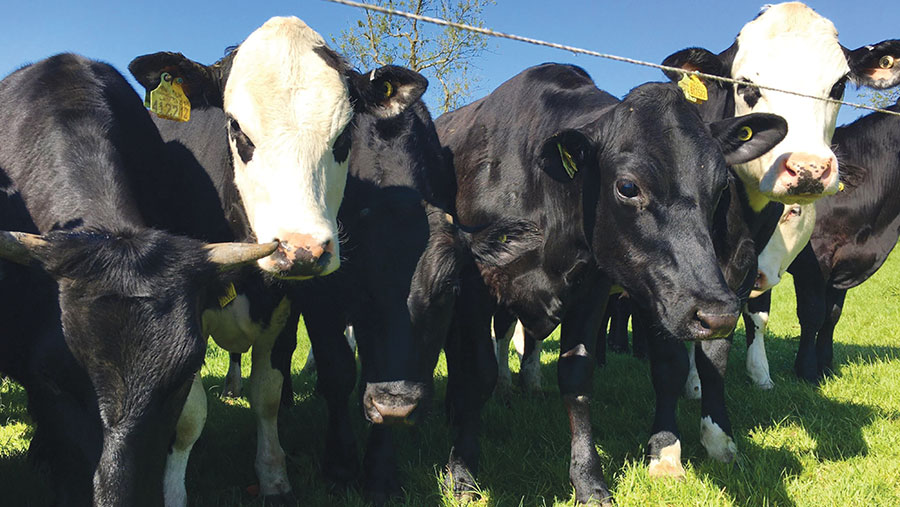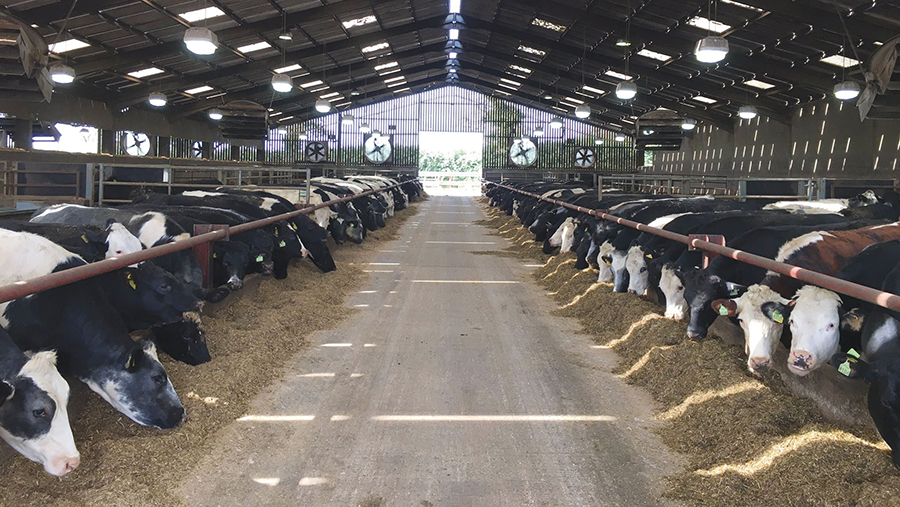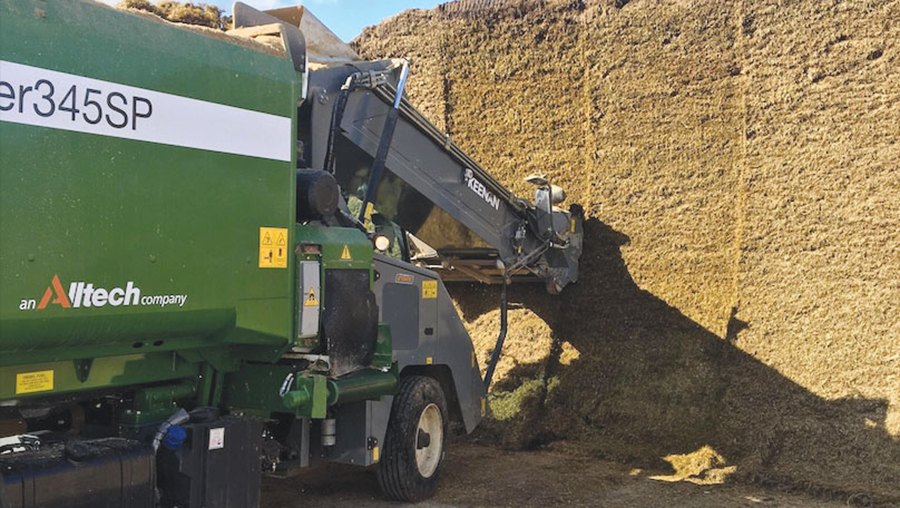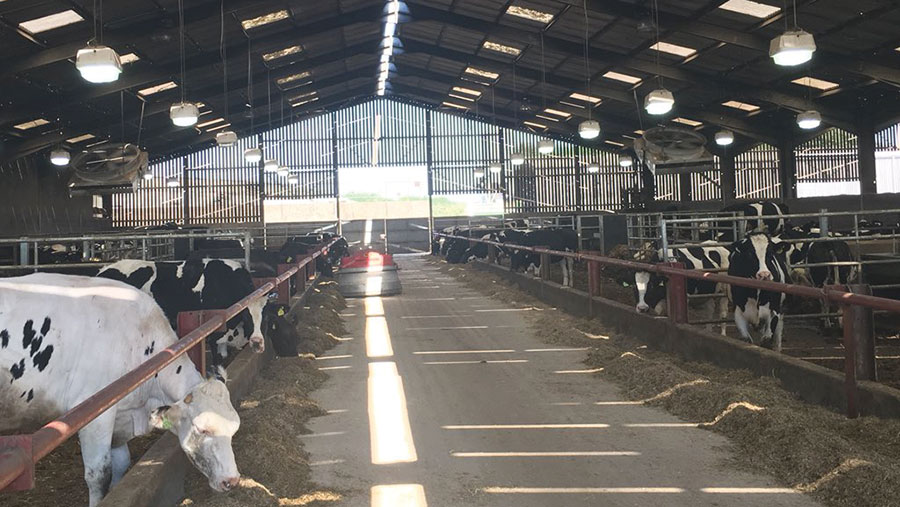Why Angus are earning an integrated finisher more than Blues
 © StraightLine Beef
© StraightLine Beef Angus-sired cattle are outperforming Blue-cross cattle in a dairy-beef system through faster weight gains, longer grazing periods, cheaper diets and a more valuable carcass.
Continental cattle achieved a better grade and a higher carcass value when paid on Europ grid terms, but veterinarian and beef finisher Rob Drysdale says natives are more profitable when accounting for the Angus-sired premium and reduced feed costs.
See also: Alternative feeds for beef cattle and what to consider
Mr Drysdale’s business – StraightLine Beef (SLB) – is a vertically integrated, bovine TB-restricted beef finishing supply chain based near Shepton Mallet, Somerset.
Data collected at SLB on Farm Wizard and, most recently AgriWebb, shows Angus cattle can be finished faster and cheaper than the Blues. Furthermore, a Harper Adams University dissertation study on the business underlined the superior margin generated by the more valuable Angus cattle. A flat rate is paid for two- to four-week-old calves when they enter rearing units from the dairy supplier.
Mr Drysdale says the results have left him questioning whether SLB should reduce the price paid for Blue calves.
StraightLine Beef
- Capacity for about 4,000 cattle across five units
- Kills about 300 cattle a month
- Sells 150-180 stores a year at Sedgemoor
- Supplies Alec Jarrett, Buitelaar and Tesco on an Angus contract
- Takes intensive dairy bulls and heifers to 220-250kg deadweight at 9.5-11 months
- Takes heifers to 250-280kg deadweight at 14-17.5 months and steers to 250-330kg at 14-18 months
About the trial
The study compared the carcass performance and finishing times of 50 steers and heifers (20 Blues and 30 Angus) at SLB.
Harper Adams University student Ryan Doble analysed the finishing times, weight gains and carcass performance of the cattle, which were killed between October 2019 and June 2020.
Messrs Drysdale and Doble say the Angus cattle have four advantages compared with the Blues’ two:
- Angus Greater overall carcass value, fewer days on a total mixed ration (TMR), cheaper cost/kg gained and longer grazing season
- Blue Higher kill-out percentage and better grading (more Rs).
1. Greater carcass value
Angus cattle finished at SLB are sold through the named-sire Angus scheme to Tesco, typically achieving a 30p/kg bonus over the Blues.
To achieve the full bonuses, Angus must be less than 24 months old, weigh 290-320kg deadweight and grade O+3 or O+4L or better on the Europ grid.

© StraightLine Beef
Blues make up about 10p/kg of this premium by achieving more R-grades and have slightly higher carcass weights on animals that fall in the desired fat classes of 2-4L (see “Angus cattle generate more margin”).
- Angus Angus carcasses were worth £50.84 more after all deductions and haulage due to an Angus premium of 19p/kg over the Blues. All the Angus cattle achieved an O-grade.
- Blue Blues achieved a final carcass weight 2kg heavier than the Angus cattle and a higher kill-out percentage of 51%. About 65% of the Blues achieved an R-grade, with the rest classifying Os.
- Implication Angus carcasses generated more income when accounting for the Angus premium. If both breeds were subjected to base pricing, the Blues would have generated more income by virtue of two out of three Blues achieving an R-grade.
Angus cattle generate more margin |
|||||||||
| Angus | Blue | ||||||||
| Average slaughter age (days) | 486 | 503 | |||||||
| Days on finishing diet | 57 | 67 | |||||||
| Average daily liveweight gain (kg) | 2.22 | 1.59 | |||||||
| Average carcass weight (kg) | 276.2 | 278.2 | |||||||
| Average kill-out (%) | 49 | 51 | |||||||
| Average beef price (£/kg) | 3.56 | 3.37 | |||||||
| Average carcass return (£) | 983 | 938 | |||||||
| Average deductions at slaughter and haulage (£) | 39.33 | 44.27 | |||||||
| Average total paid per carcass (£) | 944 | 894 | |||||||
2. Fewer days on feed
Both the study and farm records showed that Angus-crosses had a lower age at slaughter and spent fewer days on the finishing diet.
Usually, Angus and Blues are fed two different diets, with different starch levels and costs. However, both groups of cattle were finished on a diet costing £2.21 a head a day for the study.
The daily diet for each animal comprised 11kg of silage, 4kg of wholecrop, 0.45kg of chopped wheat straw, 10g of a microbial digestion supplement, 10kg of moist blend, 2.75kg of crimped maize and 0.12kg of mineral.
- Angus The Angus-crosses spent 57 days on feed on average (day 429-486).
- Blue The Blue-cross cattle spent 10 days longer on feed and were 17 days older at slaughter.
- Implication The study fed a ration that cost £2.21 a day, which makes the Blue cattle £22.10 dearer in finishing costs for 10 extra days on feed.

© StraightLine Beef
3. Cheaper cost per kilogramme gained
A Keenan self-propelled feeder wagon is used with In-Touch software as well as near-infrared spectroscopy forage analysis.
InTouch allows the farm to track ration costs. Cattle are usually split according to breed when transitioned from grass to allow two different diets to be fed.
The farm houses finishing cattle once they reach 400-500kg and allows 14-21 days for the rumen to adjust from grass to the final TMR. Once transitioned, cattle spend 45 days on the finishing diet and typically gain 150-170kg over the last 60-70 days.
To control costs, silage quality has to be high. In 2020, forage quality averaged 11 metabolisable energy (ME), 17-18% crude protein (CP) and 35-40% dry matter (DM) in 2020.
The aim is to finish effectively and ensure conformation and fat class are reached simultaneously at target liveweights of 560-630kg.
- Angus Natives get a “forage finisher diet”, which is currently 31% starch, 11.9ME, 16% CP and 47% DM.
- Blue Continentals get an “intensive diet” made up of 40% starch, 12.3ME, 16% CP and 54% DM.
- Implication The Blue diet costs 20p a head a day more. Over the 42-day finishing period, this amounts to £8.40. When accounting for the extra 10 days the Blues need to finish at a cost of £2.20/day, this amounts to £30.60 (£8.40 + £22.20).

StraightLineBeef
4. Longer grazing season
The system rotationally grazes cattle from early March to the end of November to reduce the overall cost/kg of liveweight gain. The longest grazers in 2020 averaged 1.11kg/day over 276 days at grass.
A baseline cost for cattle on the farm is 70p a head a day, which covers labour, rent, kit, fuel and grassland costs. However, when housed, the cost of straw and bedding-up are added and the ration cost is also more expensive.
- Angus As a native breed, these cattle are often grazed well into the autumn at SLB. Even with late grazing, native-bred stock average 0.8kg a head a day, costing about £1/kg gained.
- Blues These cattle start losing condition and require housing a month earlier than the Angus. Even on a grass silage diet and allowing for better liveweight gains, early housing costs about £1.32/kg for the extra 30 days the Blues are housed (see “How much is saved by an extra month grazing in November?”).
- Implication The Angus cattle gain an advantage here, because of the season and their higher beef price. It’s only a marginal benefit, but being able to graze cattle for longer offers flexibility.
How much is saved by an extra month grazing in November? |
||
| Angus outside | Blue inside | |
| Carcass weight gained (kg) | 12 (24kg liveweight) | 19.5 (39kg liveweight) |
| Daily liveweight gain (kg) | 0.8 | 1.3 |
| Cost/kg liveweight gained (£) | 1 | 1.32 |
| Cost of liveweight gained (£) | 24 | 51.48 |
| Value of carcass weight gained (£) * | 48.60 | 75.07 |
| Margin (£) | 24.6 | 23.59 |
| *Calculated at 385p/kg for Blues and 405p/kg for Angus. Angus cattle typically get a 15-20p/kg premium when breed premium and carcass grading are taken into account. | ||
